Have you ever wondered where do spider mites come from?
If your plants are undergoing extensive damage and you cannot determine the exact cause, chances are they have been infested by spider mites.
Spider mites seem to come out of nowhere and infest your houseplants in no time.
These creatures, though small, can cause massive destruction, mainly affecting leaves and fruits.
One may wonder, even after frequent cleaning and pampering, where these spider mites actually come from.
Table of Contents
Where do Spider Mites Come From?
Spider mites are brought into the house via your shoes, clothing, nestled in between animal fur, and, most importantly, from other infected plants. Due to their minute size, they often escape detection from the naked eye and are only noticed when it is too late.
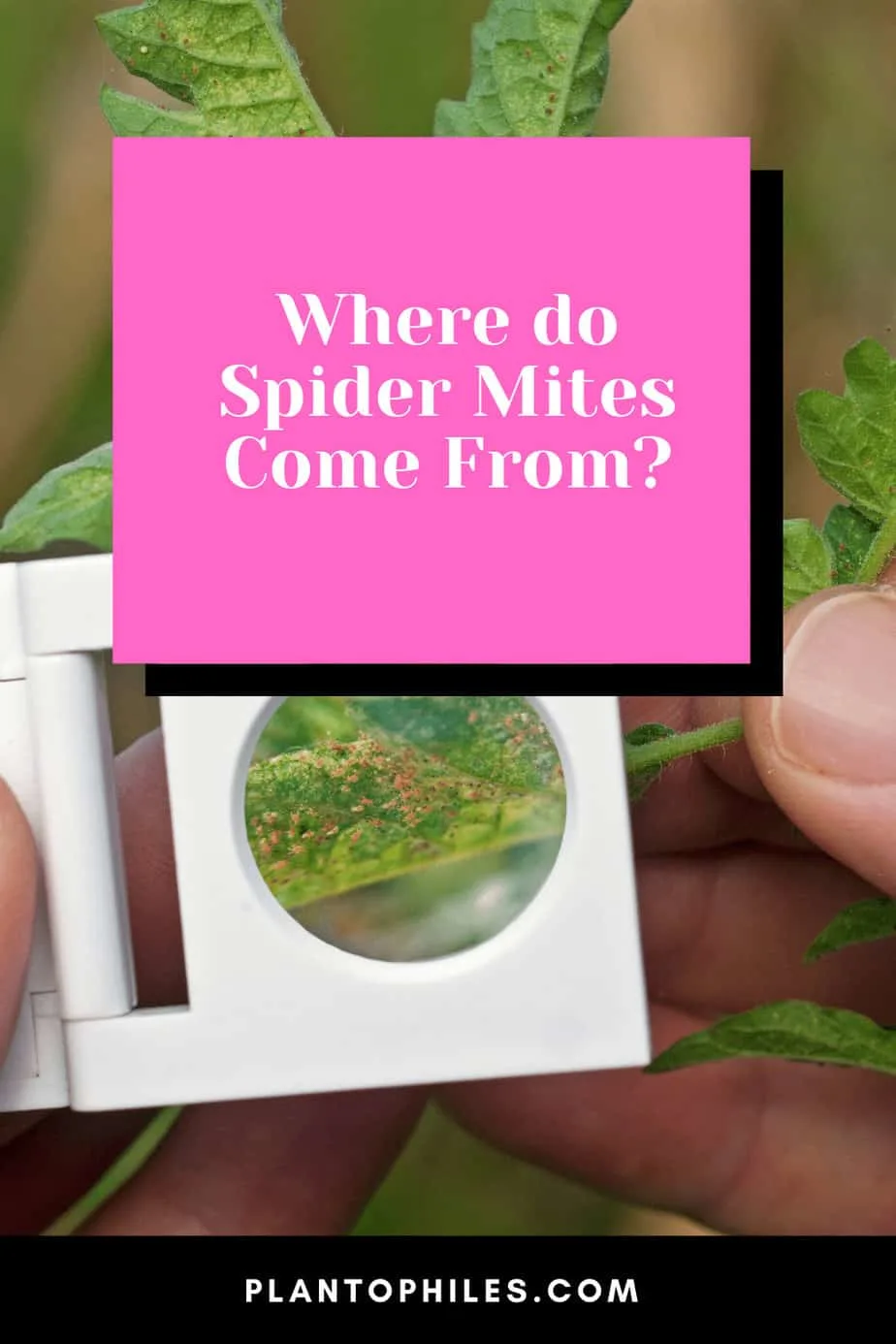
Where do Spider Mites Come From?
What are Spider Mites?
| Size | Approximately 0.3 mm to 0.5 mm (very tiny) | |||
| Classification | Arachnid | |||
| Legs | 8 | |||
| Related To | Spiders and ticks | |||
| Visibility | Requires 10x magnification (magnifying glass) | |||
| Feeding Behavior | Sucks plant's nutritious liquids | |||
It is necessary to know what any insect or pest is in order to deal with them.
Spider mites, often mistaken for insects, are a type of eight-legged Arachnid that is closely associated with spiders and ticks.
These creatures are tiny and, therefore, only visible under a commercially-available magnifying glass.
Most species of spider mites breed during the hotter seasons, feeding on over 200 plant species.
Generally, they appear as white dust particles on the underside of leaves.
If your plant is indeed infected, the dust particles would seem to be moving when you take a closer look.
Spider mites use their mouths to drink a plant’s nutritious liquids, leading to the formation of several small dots known as stippling.
As the mites multiply, they infect various plant regions, and the dots gradually morph into large discolored areas.
Although the discolored areas are easy to notice, it is most likely too late when the gardener notices and the damage is done.
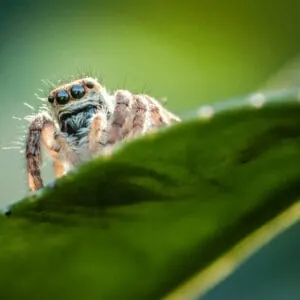
Spider mites are 8-legged and related to spiders and ticks
What are the Different Spider Mites Species?
Spider mites have over 100 species, some thriving in cooler conditions, while the majority flourishes in temperate environments.
Few of the species of spider mites feed on a limited number of plant types.
Most spider mite species are less picky and infest numerous plant types.
One of the most common species of spider mites includes the two-spotted spider mite.
This specific species feeds on over 150 plant types.
It mostly affects ornamental and agricultural plants and grows rapidly in hot climates primarily in dusty and drought-stricken areas.
The other spider mite types include the southern red mite, also called the Oligonychus illicis MacGregor, and the spruce spider mite, known by many as Oligonychus ununguius Jacobi.
Moreover, there is the famous tumid spider mite, also identified as Tetranychus tumidus Banks.
This species has a liking for juvenile plants.
The spruce spider mite or Oligonychus ununguius Jacobi, the southern red mite or Oligonychus illicis MacGregor, and the Pacific spider mite or Tetranychus pacificus MacGregor are other frequent plant inhabitants.

In dry climates egg fertility is higher in spider mites
Where do Spider Mites Thrive?
The spider mites most rapidly grow in warm, dry environments.
While these pests reproduce even in wet conditions, spider mites appear to have greater egg fertility in low-moisture areas.
They also prefer dusty settings, which allow them to blend in easily with their surroundings.
A top favorite of spider mites is plants with high levels of nitrogen, phosphorus, and carbohydrates.
While nitrogen and phosphorus encourage abundant nectar synthesis, carbohydrates serve as reliable readymade feed.
Spider mites also enjoy indoor hydroponic setups, especially the ones using some soil.
Although slightly humid, the average indoor temperatures fall within the preferred range, allowing moderate to large spider mites colonies to expand further.
Plants with leaf-spotting or nutrient deficiency should also be checked for spider mites and treated accordingly.
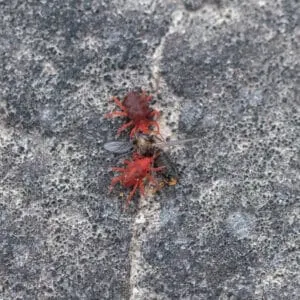
Spider mites prefer hot and dry climates
Sources of Spider Mites
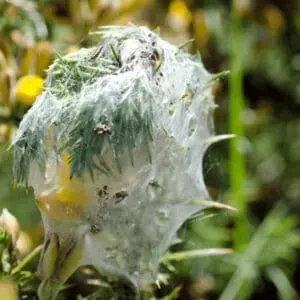
Spider mites are often brought in with plants but also via clothes, shoes and animals such as cats and dogs
1. Infected Plants
The primary source, as you might have guessed, is the plants themselves. The spider mites multiply rapidly.
Even if one plant is infested, there is a high probability that it will spread the infection to its surrounding plants soon.
The plants are at high risk even if they are at a decent distance from one another. Grouped plants will most definitely get infected by a spider mites-stricken plant.
I suggest every time you bring a new plant home, quarantine and monitor it for a few days before placing it in its designated spot.
2. Garden Centres
Other than the plants grown at home, the plants purchased from garden centers can be a common source of spider mites.
An infected plant shows signs of infestation fairly quickly; therefore, quarantine it as soon as you see characteristic symptoms of spider mites.
The tiny pests migrate from one plant to another, causing catastrophic damage.
I recommend that you exercise extra caution when buying plants from stores and ask the salesperson to check the plant thoroughly before giving it to you.
Please do not buy plants with yellow or sunken leaves, as these signs are indicative of a spider mites infection.
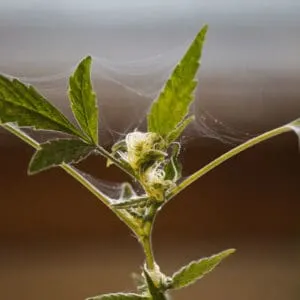
Signs of malnutrition as well as leaf spotting often leads. back to a spider mite infestation
3. Poor Hygiene
The plants become a treat for spider mites when the plants are not cleaned. Recurrent gentle washings are necessary for plants so that dust does not settle on them.
Moreover, washing can also remove any spider mites already residing on the leaves before they spread to other plants.
4. Clothes and Shoes
Spider mites can adhere to clothes and shoes exposed to dust or infected plants. Humans may bring these pests without a clue, allowing them to destroy their happy and healthy plants.
Unfortunately, clothes and shoes cannot be saved from dust and environmental pests. However, you can run your clothes through the washer and dryer to prevent the spread of spider mites.

Spider mites prefer hot and dry climates
5. Pets
Our furry friends, as wonderful as they are, are another source of spider mites. These pesky creatures can temporarily burrow themselves in the fur of animals like cats and dogs, and spread to plants.
Even generally, washing and keeping up with your pet’s good hygiene is a good idea.
Frequent brushing and bathing can rid your pets of spider mites and save your plants and your pets from problems like itching.
6. Excessive Nitrogen
Nitrogen is an essential component of plants; however, its excessive formation can lead to a long list of issues. One such problem is spider mites.
Extra nitrogen promotes the production of ‘funny proteins.’ These proteins make the plant sap sweeter, attracting several nectar-sucking insects, including spider mites.
Nitrogen helps the plant grow and flourish; however, ensuring that it only produces the needed amount is imperative for its overall health.
To avoid the overproduction of nitrogen, apply a well-balanced spectrum of nutrients.
7. Large Plants
Large plants can become a favorable breeding ground for spider mites. The significant number of plant tissues provides them with more feed to survive on.
Spider mites prefer larger plants as they have more surface area to eat away and destroy.
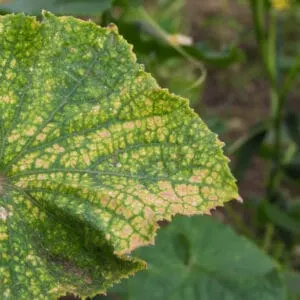
Spider mites lead to large discolored areas on the foliage of plants
Frequently Asked Questions About Where Do Spider Mites Come From
How do I get rid of spider mites?
Rubbing alcohol can get rid of spider mites. Soak some cotton balls in rubbing alcohol and wipe your affected plant’s foliage with it.
Can spider mites infect humans?
Spider mites primarily thrive on plants. They rarely bite humans; however, in rare instances, they may cause mild itching and redness on a few bitten sites.
Does vinegar kill spider mites?
Vinegar is highly acidic, and therefore, can be used to kill spider mites. To prepare a solution, dilute some vinegar in water and spray over your infested plants.

Daniel has been a plant enthusiast for over 20 years. He owns hundreds of houseplants and prepares for the chili growing seasons yearly with great anticipation. His favorite plants are plant species in the Araceae family, such as Monstera, Philodendron, and Anthurium. He also loves gardening and is growing hot peppers, tomatoes, and many more vegetables.


